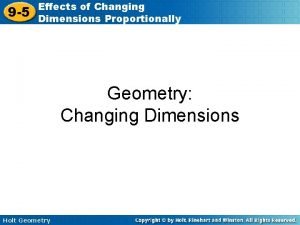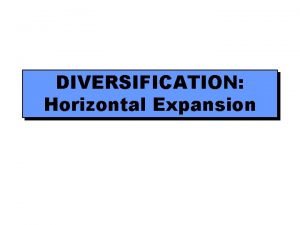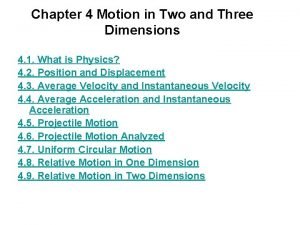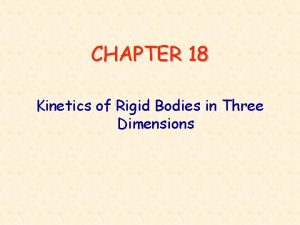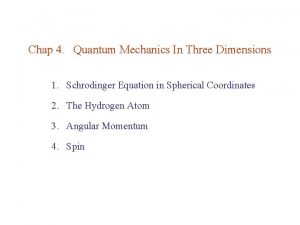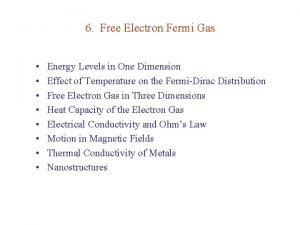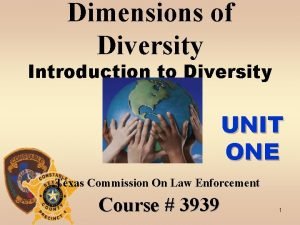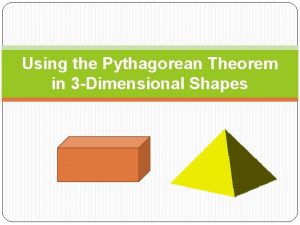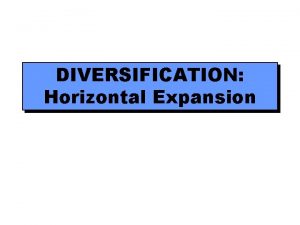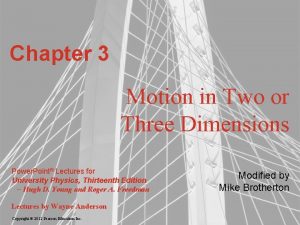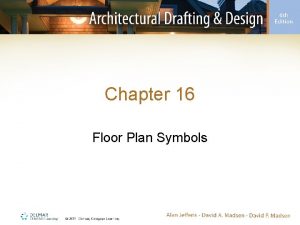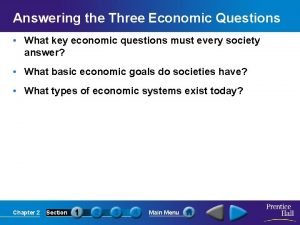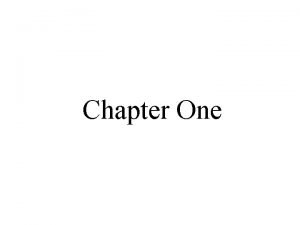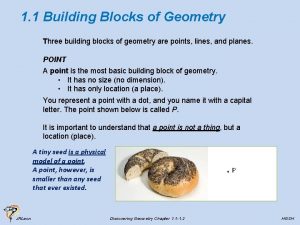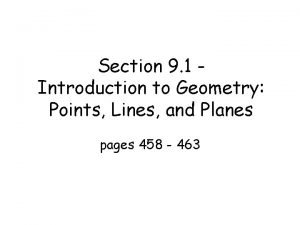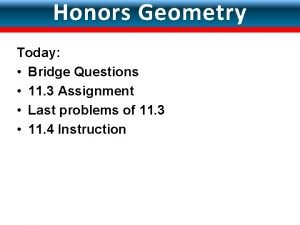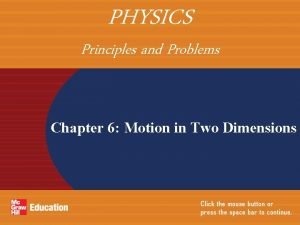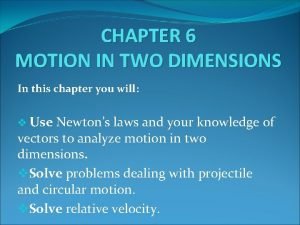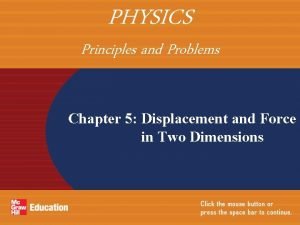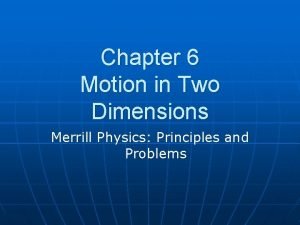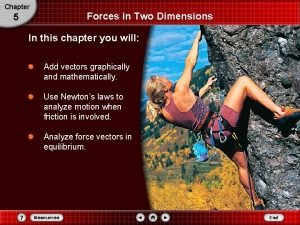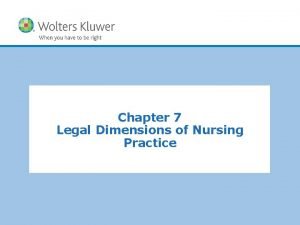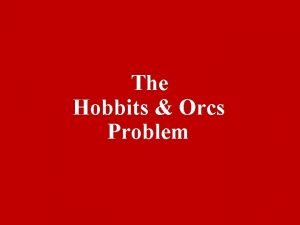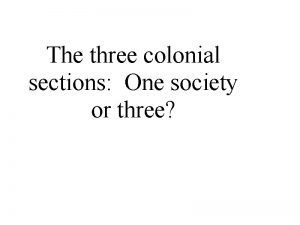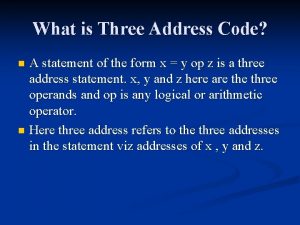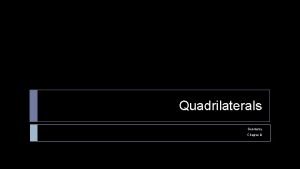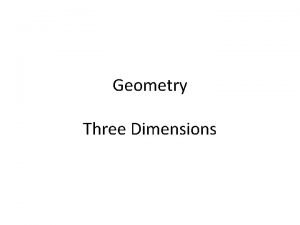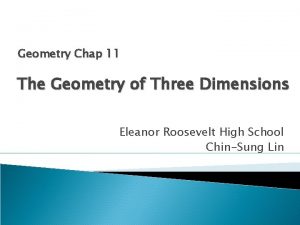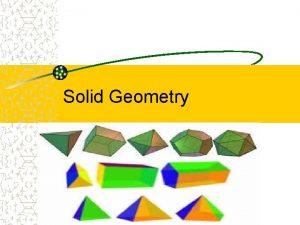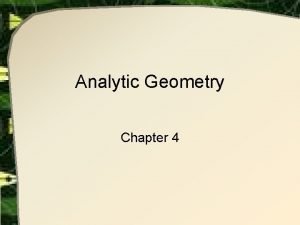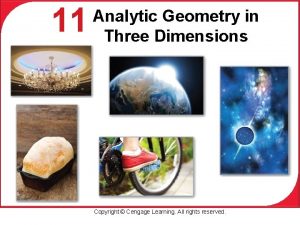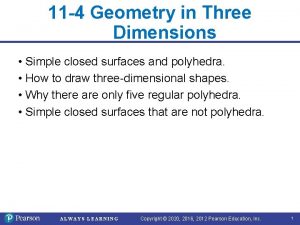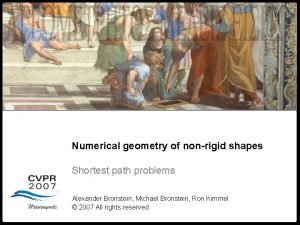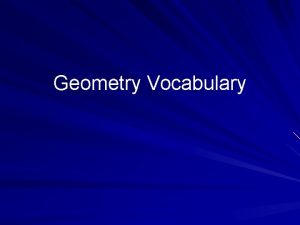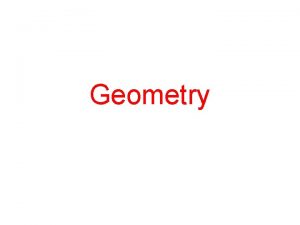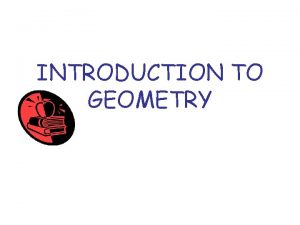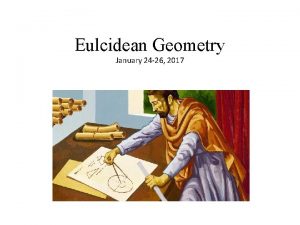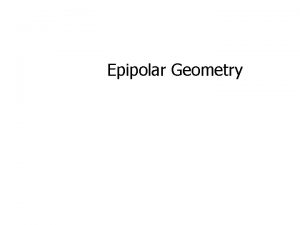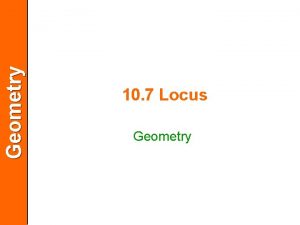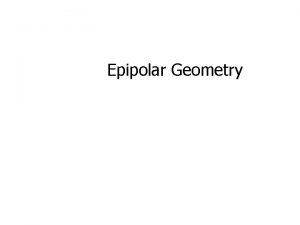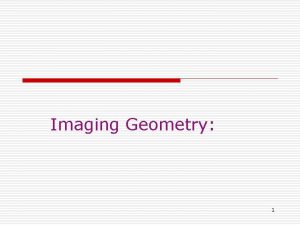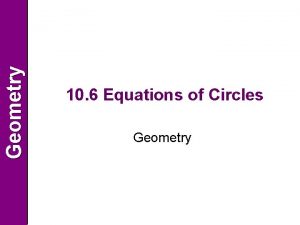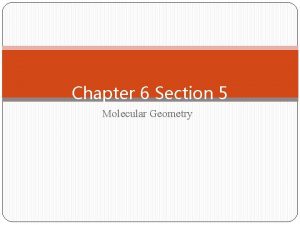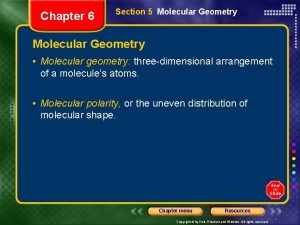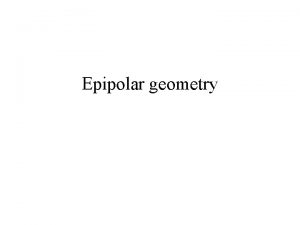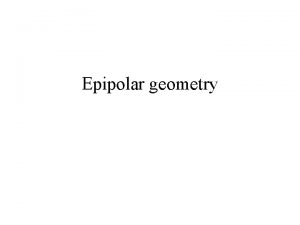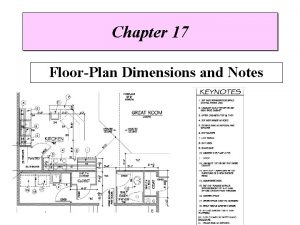CHAPTER 11 THE GEOMETRY OF THREE DIMENSIONS Section




















































































- Slides: 84

CHAPTER 11 THE GEOMETRY OF THREE DIMENSIONS Section 11 -1 Points, Lines, and Planes Section 11 -2 Perpendicular Lines and Planes Section 11 -3 Parallel Lines and Planes C. N. Colón St. Barnabas H S Geometry

DO NOW Find the area of the rhombus: 10 10 12 12

Objectives: • You will review, develop and apply postulates for points lines and planes • Explore the properties of parallel and perpendicular lines and planes

RECALL THAT A POINT IS AN EXACT LOCATION IN SPACE. You are here.

A TRUE POINT HAS NO LENGTH NO WIDTH NO HEIGHT. In fact, you cannot see a true point.

A POINT IS NAMED BY A LETTER. Point P P

A line is a 1 -dimensional object that has only length r i d h t o b n s n o i ect i r e orev e n i l A f s e u n i t con

Because a line has no width or height, you cannot see a true line.

A LINE IS DEFINED BY 2 POINTS. A Line AB B

A RAY HAS A STARTING POINT BUT NO ENDING POINT.

JUST AS A RAY OF LIGHT HAS A STARTING POINT AND CONTINUES FOREVER IN THE SAME DIRECTION. SO TOO DOES A RAY IN GEOMETRY

OF COURSE, IF THE RAY HITS AN OBJECT, THE LIGHT COULD BE ABSORBED OR REFLECTED. but that is a topic for another course…. such as physics

A RAY IS ALSO DEFINED BY 2 POINTS. C Ray CD D

A LINE SEGMENT HAS A STARTING POINT AND AN ENDING POINT. LINE SEGMENTS CAN BE MEASURED.

A LINE SEGMENT IS ALSO DEFINED BY 2 POINTS. E Line Segment EF F

Ray BA A B To read a ray, start at the end point and go towards the arrow Note that AB is the same as BA and AB is the same as BA. However, AB and BA are not the same. They have different initial points and extend in opposite directions. A l B Line l or AB

LINES CAN DO VARIOUS THINGS.

LINES CAN INTERSECT AT A POINT TO FORM ANGLES. X Y Z

ANGLES ARE DEFINED BY 3 POINTS. X Y XYZ Z

Lines can intersect to form right angles 90

…AND THESE ANGLES ARE RIGHT ANGLES. R RST = 90⁰ USR = 90⁰ c S U T VST = 90⁰ USV = 90⁰ V

WHEN LINES INTERSECT TO FORM RIGHT ANGLES, THEY ARE SAID TO BE PERPENDICULAR. R c U UT RV S V T

LINES CAN INTERSECT TO FORM ACUTE AND OBTUSE ANGLES. 45 acute 135 obtuse

LINES CAN ALSO RUN INTO EACH OTHER TO FORM STRAIGHT ANGLES.

180 is a straight angle

LINES DO NOT ALWAYS INTERSECT.

LINES CAN BE PARALLEL.

Two non-vertical lines are parallel iff they have the same slope.

The Transitive Property of Parallel Lines Let ℓ 1, ℓ 2, and ℓ 3 be three coplanar lines. Prove that if ℓ 1 is parallel to ℓ 2 and ℓ 2 is parallel to ℓ 3 , then ℓ 1 is parallel to ℓ 3.

Given: ℓ 1║ℓ 2 and ℓ 2║ℓ 3 Prove: ℓ 1║ℓ 3 STATEMENT 1. ℓ 1║ℓ 2 and ℓ 2║ℓ 3 2. Let m 1, m 2, and m 3 be the slopes of ℓ 1, ℓ 2, and ℓ 3 3. m 1 = m 2 and m 2 = m 3 4. m 1 = m 3 5. ℓ 1 and ℓ 3 are parallel REASON 1. Given 2. Slopes of non-vertical lines are represented by m 3. Parallel lines have the same slope 4. Transitive Property of Equality 5. Parallel Lines have the same slope

ARE LINES THAT DO NOT INTERSECT ALWAYS PARALLEL? Believe it or not, it is possible for lines that do not intersect to also not be parallel.

LET’S CONSIDER A 3 -DIMENSIONAL OBJECT SUCH AS A CEREAL BOX. THIS SOLID HAS A SPECIAL NAME: RECTANGULAR PRISM.

Notice the 2 lines that do not intersect Notice that they also are not parallel.

Definition: Skew lines are lines in space that are neither parallel nor intersecting.

Two lines are SKEW iff they are not parallel and do not intersect. (For lines to be skew they must be in different planes

AT A BARBECUE A “SKEWER” MAY BE USED. S K E W E R

A SKEWER RAISES THE FOOD OFF THE SURFACE OF THE GRILL. IT IS NOT PARALLEL TO THE GRILL AND IT DOES NOT INTERSECT OR TOUCH THE GRILL.

IN A SOCCER FIELD THE GOAL POSTS AND SIDE LINES ARE SKEW LINES

HERE IS A RECTANGULAR PRISM WITH SKEW LINES DRAWN

SUMMARY OF LINES intersecting perpendicular 90º skew parallel

Identify the relationships between the lines that are formed by the edges of the cube There are many relationships: A pair of parallel lines: ____ and ____ A pair of perpendicular lines: ____ and ____ A pair of skew lines are: ____ and _____

A plane is a flat surface that has length & width but no height.

YOU CAN SEE A PLANE ONLY IF YOU VIEW IT AT A CERTAIN ANGLE.

A TRUE PLANE GOES ON FOREVER IN ALL DIRECTIONS.

A TRUE PLANE GOES ON FOREVER IN ALL DIRECTIONS.

A TRUE PLANE GOES ON FOREVER IN ALL DIRECTIONS.

A TRUE PLANE GOES ON FOREVER IN ALL DIRECTIONS.

A TRUE PLANE GOES ON FOREVER IN ALL DIRECTIONS.

A plane extends in two dimensions. It is usually represented by a shape that looks like a tabletop or wall. You must imagine that the plane extends without end even though the drawing of a plane appears to have edges. A B M C Plane M or plane ABC The 3 points are noncollinear

Theorem 11. 1 There is exactly one plane containing a line and a point not on the line A B C

Theorem 11. 2: Two intersecting lines determine a plane. Another way of saying this is if two lines intersect then there is exactly one plane containing them

The definition of parallel lines gives us another set of points that must lie in a plane. Definition: Parallel lines are lines that lie in the same plane and have no points in common. Thus, two lines are parallel iff they are coplanar and have no points in common.

The geometry of three dimensions is called solid geometry. Recall the coordinate plane where you had an x-axis and a y-axis.

The geometry of three dimensions involves three axes

If two planes intersect then they intersect in exactly one line

When planes intersect they form an angle.

Definition p. 424 A dihedral angle is the union of two half planes with a common edge.

Where you are sitting is made up of two half planes. These form an angle where you place yourself. The two half planes of a seat intersect at exactly one line.

AN X-WING FIGHTER FROM STAR WARS HAS WINGS THAT INTERSECT.


Planes can be perpendicular. Definition p. 424: Perpendicular planes are two planes that intersect to form a right dihedral angle

Planes can be parallel.

A TIE FIGHTER FROM STAR WARS HAS WINGS THAT ARE PARALLEL.

Parallel planes found in a rock formation on a beach south of Anchorage, Alaska.

Intersecting planes and parallel planes in an architectural design by Hawkins and Associates in Reno, Nevada

Intersecting planes in interior design The Atlas Chair by Scott Jarvie

Intersecting planes used in the description of the human body

“Two Intersecting Planes” by Sascha Ledinsky based on an M. C. Escher print.

INTERSECTING PLANES IN ORIGAMI

INTERSECTING PLANES IN FELT SPONGE ARTWORK

Intersecting planes of red blood cells.

Intersecting Planes in a molecule of water

Planes can be parallel intersecting perpendicular

Identify two planes that appear to have the given relationship. 1. parallel planes _______and _______ 2. perpendicular planes _______and _______ 3. neither parallel nor perpendicular _______ and ____

SKETCHING INTERSECTIONS A line that intersects a plane in one point Ø Ø Ø Draw a plane and a line. Emphasize the point where they meet. Dashes below the point indicate where the line is hidden by the plane


SKETCHING INTERSECTING PLANES

AND NOW --- A SUMMARY PLEASE do not memorize them - you must understand each of them! Go slowly and visualize each situation before answering any questions on a quiz, or on a test.

SUMMARY OF THEOREMS: CH. 11 -1 • There is one and only one plane containing three non-collinear points • A plane containing any two points contains all the points on the line determined by those two points • There is exactly one plane containing a line and a point not on the line • If two lines intersect, there is exactly one plane containing them, in other words, two intersecting lines determine a plane • DEFINITION: Parallel lines in space are lines in the same plane that have no points in common • DEFINITION: Skew lines are lines in space that are neither parallel nor intersecting

SUMMARY OF THEOREMS: CH 11 -2 • If two planes intersect, then they intersect in exactly one line. • DEFINTION: A dihedral angle is the union of two halfplanes with a common edge (line) • DEFINTION: The measure of a dihedral angle is the measure of the plane angle formed by two rays each in a different half-plane of the angle and each perpendicular to the common edge at the same point of the edge. • DEFINITION: Perpendicular planes are two planes that intersect to form a right dihedral angle • If a line not in a plane intersects the plane, then it intersects it in exactly one point. • DEFINITION: A line is perpendicular to a plane iff it is perpendicular to each line in the plane through the intersection of the line and the plane

SUMMARY OF THEOREMS: CH 11 -2 CONT’D • • • DEFINITION: A plane is perpendicular to a line if a line is perpendicular to a plane. At a given point on a line , there are infinitely many lines perpendicular to the given line If a line is perpendicular to each of two intersecting lines at their point of intersection, then the line is perpendicular to the plane determined by these lines. If two planes are perpendicular to each other, one plane contains a line perpendicular to the other plane. Conversely, if a plane contains a line perpendicular to another plane, then the planes are perpendicular DEFINITION: Two planes are perpendicular iff one plane contains a line perpendicular to the other. (biconditional)

SUMMARY OF THEOREMS: CH 11 -2 CONT’D • • Through a given point on a plane, there is only one line perpendicular to the given plane. Through a given point on a line, there can be only one plane perpendicular to the given line. If a line is perpendicular to a plane , then any line perpendicular to the given line at its point of intersection with the given plane, is in the plane. If a line is perpendicular to a plane, then every plane containing the line is perpendicular to the plane.

SUMMARY OF THEOREMS: CH 11 -3 • Parallel planes are planes that have no point in common • If a plane intersects two parallel planes, then the intersection is two parallel lines • Two lines perpendicular to the same plane are parallel • Two lines perpendicular to the same plane are coplanar. • If two planes are perpendicular to the same line, then they are parallel – Conversely, if two planes are parallel, then a line perpendicular to one of the planes is perpendicular to the other. • Two planes are perpendicular to the same line iff the planes are parallel. (Biconditional) • DEFINITION: the distance between two planes is the length of the line segment perpendicular to both planes with an endpoint on each plane. • Parallel planes are everywhere equidistant

HOMEWORK p. 422 #4 -12 (e) p. 432 #4 -20 (mo 4) p. 439 # 4 -12 (mo 4)
 Changing dimensions geometry
Changing dimensions geometry Lewis structure of pf3
Lewis structure of pf3 Electron domain geometry vs molecular geometry
Electron domain geometry vs molecular geometry Electron geometry vs molecular geometry
Electron geometry vs molecular geometry Three dimensions of corporate strategy
Three dimensions of corporate strategy What are the three dimensions of corporate strategy
What are the three dimensions of corporate strategy Motion in two and three dimensions
Motion in two and three dimensions Kinetic of rigid body
Kinetic of rigid body Quantum mechanics in three dimensions
Quantum mechanics in three dimensions Free electron gas
Free electron gas Three dimensions of justice
Three dimensions of justice The three dimensions of critical thinking are
The three dimensions of critical thinking are 4 layers of diversity
4 layers of diversity व्हाट इस डाइवर्सिटी
व्हाट इस डाइवर्सिटी Pythagoras theorem on 3d shapes
Pythagoras theorem on 3d shapes Three dimensions of corporate strategy
Three dimensions of corporate strategy Three dimensions of corporate strategy
Three dimensions of corporate strategy Motion in two or three dimensions
Motion in two or three dimensions Vertical integration
Vertical integration Three dimensions of global inclusion
Three dimensions of global inclusion What are the three dimensions of critical thinking
What are the three dimensions of critical thinking Section plan with dimensions
Section plan with dimensions Chapter 2 section 1 answering the three economic questions
Chapter 2 section 1 answering the three economic questions Chapter 2 section 1 answering the three economic questions
Chapter 2 section 1 answering the three economic questions What are the 3 undefined terms of geometry
What are the 3 undefined terms of geometry Geometry building blocks
Geometry building blocks Chapter 10 meiosis 1 and meiosis 2
Chapter 10 meiosis 1 and meiosis 2 Section 1 introduction to geometry answers
Section 1 introduction to geometry answers 11-4 area of regular polygons
11-4 area of regular polygons Hát kết hợp bộ gõ cơ thể
Hát kết hợp bộ gõ cơ thể Slidetodoc
Slidetodoc Bổ thể
Bổ thể Tỉ lệ cơ thể trẻ em
Tỉ lệ cơ thể trẻ em Gấu đi như thế nào
Gấu đi như thế nào Tư thế worm breton
Tư thế worm breton Chúa yêu trần thế
Chúa yêu trần thế Các môn thể thao bắt đầu bằng tiếng nhảy
Các môn thể thao bắt đầu bằng tiếng nhảy Thế nào là hệ số cao nhất
Thế nào là hệ số cao nhất Các châu lục và đại dương trên thế giới
Các châu lục và đại dương trên thế giới Công thức tính thế năng
Công thức tính thế năng Trời xanh đây là của chúng ta thể thơ
Trời xanh đây là của chúng ta thể thơ Cách giải mật thư tọa độ
Cách giải mật thư tọa độ Làm thế nào để 102-1=99
Làm thế nào để 102-1=99 Phản ứng thế ankan
Phản ứng thế ankan Các châu lục và đại dương trên thế giới
Các châu lục và đại dương trên thế giới Thơ thất ngôn tứ tuyệt đường luật
Thơ thất ngôn tứ tuyệt đường luật Quá trình desamine hóa có thể tạo ra
Quá trình desamine hóa có thể tạo ra Một số thể thơ truyền thống
Một số thể thơ truyền thống Bàn tay mà dây bẩn
Bàn tay mà dây bẩn Vẽ hình chiếu vuông góc của vật thể sau
Vẽ hình chiếu vuông góc của vật thể sau Biện pháp chống mỏi cơ
Biện pháp chống mỏi cơ đặc điểm cơ thể của người tối cổ
đặc điểm cơ thể của người tối cổ V cc cc
V cc cc Vẽ hình chiếu đứng bằng cạnh của vật thể
Vẽ hình chiếu đứng bằng cạnh của vật thể Fecboak
Fecboak Thẻ vin
Thẻ vin đại từ thay thế
đại từ thay thế điện thế nghỉ
điện thế nghỉ Tư thế ngồi viết
Tư thế ngồi viết Diễn thế sinh thái là
Diễn thế sinh thái là Các loại đột biến cấu trúc nhiễm sắc thể
Các loại đột biến cấu trúc nhiễm sắc thể Số nguyên tố là gì
Số nguyên tố là gì Tư thế ngồi viết
Tư thế ngồi viết Lời thề hippocrates
Lời thề hippocrates Thiếu nhi thế giới liên hoan
Thiếu nhi thế giới liên hoan ưu thế lai là gì
ưu thế lai là gì Hươu thường đẻ mỗi lứa mấy con
Hươu thường đẻ mỗi lứa mấy con Sự nuôi và dạy con của hươu
Sự nuôi và dạy con của hươu Sơ đồ cơ thể người
Sơ đồ cơ thể người Từ ngữ thể hiện lòng nhân hậu
Từ ngữ thể hiện lòng nhân hậu Thế nào là mạng điện lắp đặt kiểu nổi
Thế nào là mạng điện lắp đặt kiểu nổi Chapter 6 study guide motion in two dimensions
Chapter 6 study guide motion in two dimensions Chapter 6 motion in two dimensions
Chapter 6 motion in two dimensions Chapter 6 motion in two dimensions
Chapter 6 motion in two dimensions 5 displacement and force in two dimensions
5 displacement and force in two dimensions Chapter 6 motion in two dimensions answer key
Chapter 6 motion in two dimensions answer key Chapter 5 forces in two dimensions worksheet answers
Chapter 5 forces in two dimensions worksheet answers Dimensions of nursing practice
Dimensions of nursing practice Hobbits orcs
Hobbits orcs Othello act three scene three
Othello act three scene three In three minutes write
In three minutes write Orange diamond-shaped signs warn the motorist of
Orange diamond-shaped signs warn the motorist of The three colonial sections-one society or three
The three colonial sections-one society or three 3 address code
3 address code Quiz 8-1 angles of polygons and parallelograms
Quiz 8-1 angles of polygons and parallelograms
